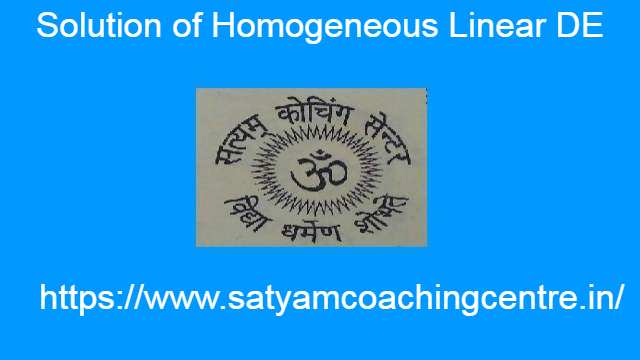Solution of Homogeneous Linear DE
1.समघाती रैखिक अवकल समीकरण का हल (Solution of Homogeneous Linear DE),समघाती रैखिक अवकल समीकरण का हल ज्ञात करने की विधि (Method of Solution of Homogeneous Linear Differential Equations):
समघाती रैखिक अवकल समीकरण का हल (Solution of Homogeneous Linear DE) ज्ञात करने के लिये हम स्वतन्त्र चर x को एक नए चर z में परिवर्तित करते हैं।इसके पश्चात पिछली विधियों के द्वारा सहायक समीकरण से पूरक फलन तथा विशिष्ट हल ज्ञात करते हैं।पुनः चर z को स्वतन्त्र चर x में परिवर्तित कर लेते हैं।
आपको यह जानकारी रोचक व ज्ञानवर्धक लगे तो अपने मित्रों के साथ इस गणित के आर्टिकल को शेयर करें।यदि आप इस वेबसाइट पर पहली बार आए हैं तो वेबसाइट को फॉलो करें और ईमेल सब्सक्रिप्शन को भी फॉलो करें।जिससे नए आर्टिकल का नोटिफिकेशन आपको मिल सके । यदि आर्टिकल पसन्द आए तो अपने मित्रों के साथ शेयर और लाईक करें जिससे वे भी लाभ उठाए । आपकी कोई समस्या हो या कोई सुझाव देना चाहते हैं तो कमेंट करके बताएं।इस आर्टिकल को पूरा पढ़ें।
Also Read This Article:-Homogeneous Linear DE
2.समघाती रैखिक अवकल समीकरण का हल के साधित उदाहरण (Solution of Homogeneous Linear DE Solved Examples):
निम्नलिखित अवकल समीकरणों का हल ज्ञात कीजिए:
(Solve the following differential equations):
Example:1. x^{3} \frac{d^{3} y}{d x^{3}}+2 x^{2} \frac{d^{2} y}{d x^{2}}+3 x \frac{d y}{d x}-3 y=x^{2}+x
Solution: x^{3} \frac{d^{3} y}{d x^{3}}+2 x^{2} \frac{d^{2} y}{d x^{2}}+3 x \frac{d y}{d x}-3 y=x^{2}+x
माना कि z=\log _{e} x \Rightarrow x=e^{z}
अतः दिए हुए समीकरण को निम्न रूप में रख सकते हैं:
[D(D-1)(D-2)+2 D(D-1)+3 D-3] y=e^{2z}+e^{z} \\ \Rightarrow \left[D^{3}-3 D^{2}+2 D+2 D^{2}-2 D+3 D-3\right] y=e^{2z}+e^{z} \\ \Rightarrow \left(D^{3}-D^{2}+3 D-3\right) y=e^{2z}+e^{z}
इसका सहायक समीकरण (A.E.) होगा:
m^{3}-m^{2}+3 m-3=0 \\ \Rightarrow m^{2}(m-1)+3(m-1)=0 \\ \Rightarrow (m-1) \left(m^{2} +3\right)=0 \\ \Rightarrow m=1, m^{2}=\sqrt{-3} \\ \Rightarrow m=\pm \sqrt{3} i \\ \Rightarrow m=1, \pm \sqrt{3} i\\ \text{C.F.}= c_{1} e^{2}+c_{2} \cos (\sqrt{3} z)+c_{3} \sin (\sqrt{3} z) \\ \Rightarrow \text{C.F.}=c_{1} x+c_{2} \cos (\sqrt{3} \log x)+c_{3} \sin (\sqrt{3} \log x) \\ \text{P.I.}=\frac{1}{(D-1)\left(D^{2}+3\right)} e^{2 z}+e^{z} \\ = \frac{1}{\left(D^{3}-D^{2}+3 D-3\right)} e^{2 z}+e^{z}\\ =\frac{1}{\left(D^{3}-D^{2}+3 D-3\right)} e^{2 z}+\frac{1}{\left(D^{3}-D^{2}+3 D-3\right)} e^{z} \\ =\frac{1}{\left(2^{3}-2^{2}+3 \times 2-3\right)} e^{2 z}+\frac{1}{(D-1)\left(D^{2}+3\right)} e^{z} \\ =\frac{1}{8-4+6-3}e^{2 z}+\frac{1}{(D-1)\left(1^{2}+3\right)} e^{z} \\ =\frac{1}{7} e^{2 z}+\frac{1}{4} \cdot \frac{z}{1 !} e^{z} \\ =\frac{1}{7} x^{2}+\frac{1}{4} x \log x \\ \text {P.I.}=\frac{1}{7} x^{2}+\frac{1}{4} x \log x
अतः दिए हुए समीकरण का व्यापक हल होगा:
y=C.F.+P.I.
y=c_{1} x+c_{2} \cos (\sqrt{3} \log x)+c_{3} \sin (\sqrt{3} \log x) +\frac{1}{7} x^{2}+\frac{1}{4} x \log x
Example:2. x^{3} \frac{d^{2} y}{d x^{2}}-2 x^{2} \frac{d y}{d x}+2 x y=1
Solution: x^{3} \frac{d^{2} y}{d x^{2}}-2 x^{2} \frac{d y}{d x}+2 x y=1
दोनों पक्षों में x का भाग देने पर:
x^{2} \frac{d^{2} y}{d x^{2}}-2 x \frac{d y}{d x}+2 y=\frac{1}{x}
माना कि z=\log _{e} x \Rightarrow x=e^{z}
अतः दिए हुए समीकरण को निम्न रूप में रख सकते हैं:
[D(D-1)-2 D+2] y=e^{-z} \\ \Rightarrow {\left[D^{2}-D-2 D+2\right] y=e^{-z} } \\ \Rightarrow \left(D^{2}-3 D+2\right) y=e^{-z}
इसका सहायक समीकरण (A.E.) होगा:
m^{2}-3 m+2=0 \\ \Rightarrow m^{2}-2 m-m+2=0 \\ \Rightarrow m(m-2)-1(m-2)=0 \\ \Rightarrow (m-1)(m-2)=0 \\ \Rightarrow m=1,2 \\ \text{C.F.}=c_{1} e^{z}+c_{2} e^{2 z} \\ \Rightarrow \text{C.F.}=c_{1} x+c_{2} x^{2} \\ \text{P.I.}=\frac{1}{\left(D^{2}-3 D+2\right)} e^{z} \\ =\frac{1}{(-1)^{2}-3 \times-1+2} e^{-z} \\ =\frac{1}{1+3+2} e^{-z} \\ \Rightarrow \text{P.I.} =\frac{1}{6 x}
अतः दिए हुए समीकरण का व्यापक हल होगा:
y=C.F.+P.I.
\Rightarrow y=c_{1} x+c_{2} x^{2}+\frac{1}{6 x}
Example:3. x \frac{d^{2} y}{d x^{2}}+2 \frac{d y}{d x}=6 x^{3}
Solution: x \frac{d^{2} y}{d x^{2}}+2 \frac{d y}{d x}=6 x^{3}
दोनों पक्षों में x का भाग देने पर:
x^{2} \frac{d^{2} y}{d x^{2}}+2 x \frac{d y}{d x}=6 x^{4}
माना कि z=\log _{e} x \Rightarrow x=e^{z}
अतः दिए हुए समीकरण को निम्न रूप में रख सकते हैं:
[D(D-1)+2 D] y=6 e^{4 z} \\ \Rightarrow\left(D^{2}-D+2 D\right) y=6 e^{4 z} \\ \Rightarrow \left(D^{2}+D\right) y=6 e^{4 z}
इसका सहायक समीकरण (A.E.) होगा:
m^{2}+m=0 \\ \Rightarrow m(m+1)=0 \\ \Rightarrow m=0,-1 \\ \text{C.F.}=c_{1}+c_{2} e^{-z} \\ \Rightarrow \text{C.F.}= c_{1}+c_{2} x^{-1} \\ \text{P.I.}=\frac{1}{D^{2}+D} 6 e^{4 z} \\ = 6 \frac{1}{(4)^{2}+4} e^{4 z} \\ = \frac{6}{20} e^{42} \\ \Rightarrow \text{P.I.}=\frac{3}{12} x^{4}
अतः दिए हुए समीकरण का व्यापक हल होगा:
y=C.F.+P.I.
\Rightarrow y=c_{1}+c_{2} x^{-1}+\frac{3}{10} x^{4}
Example:4. x^{2} \frac{d^{2} y}{d x^{2}}-x \frac{d y}{d x}-3 y=x^{2} \log x
Solution: x^{2} \frac{d^{2} y}{d x^{2}}-x \frac{d y}{d x}-3 y=x^{2} \log x
माना कि z=\log _{e} x \Rightarrow x=e^{z}
अतः दिए हुए समीकरण को निम्न रूप में रख सकते हैं:
[D(D-1)-D-3] y=e^{2 z} \cdot z \\ \Rightarrow \left(D^{2}-D-D-3\right) y=e^{2 z} \cdot z \\ \Rightarrow \left(D^{2}-2 D-3\right) y=e^{2 z} \cdot z
इसका सहायक समीकरण (A.E.) होगा:
m^{2}-2 m-3=0 \\ \Rightarrow m^{2}-3 m+m-3=0 \\ \Rightarrow m(m-3)+1(m-3)=0 \\ \Rightarrow(m-3)(m+1)=0 \\ \Rightarrow m=3,-1 \\ \text{C.F.}=c_{1} e^{3 z}+c_{2} e^{-z} \\ \Rightarrow \text{C.F.}=c_{1} x^{3}+c_{2} x^{-1} \\ \text{P.I.}=\frac{1}{D^{2}-2 D-3} e^{2 z} \cdot z \\ =e^{2 z} \cdot \frac{1}{(D+2)^{2}-2(D+2)-3} z \\ =e^{2 z} \cdot \frac{1}{D^{2}+4 D+4-2 D-4-3} z \\ =e^{2 z} \cdot \frac{1}{D^{2}+2 D-3} z \\ =-\frac{1}{3} e^{2 z} \frac{1}{1-\left(\frac{D^{2}+2 D}{3}\right)} z \\ =-\frac{1}{3} e^{2 z}\left[1-\left(\frac{D^{2}+2 D}{3}\right)\right]^{-1} z \\ =-\frac{1}{3} e^{2 z}\left[1+\left(\frac{D^{2}+2 D}{3}\right)+\left(\frac{D^{2}+2 D}{3}\right)^{2}+\cdots \right]z \\ =-\frac{1}{3} e^{2 z}\left[1+\frac{2 D}{3}+\frac{1}{9} D^{2}+\cdot \cdot\right] z \\ =-\frac{1}{3} e^{2 z}\left(z+\frac{2}{3}\right) \\ \Rightarrow \text{P.I.} =-\frac{1}{3} \cdot x^{2}\left(\log x+\frac{2}{3}\right)
अतः दिए हुए समीकरण का व्यापक हल होगा:
y=C.F.+P.I.
Example:5. x^{2}\left(\frac{d^{2} y}{d x^{2}}\right)-5 x \frac{d y}{d x}+9 y =x^{2} \log x
Solution: x^{2}\left(\frac{d^{2} y}{d x^{2}}\right)-5 x \frac{d y}{d x}+9 y =x^{2} \log x
माना कि x=\log e^{x} \Rightarrow x=e^{z}
अतः दिए हुए समीकरण को निम्न रूप में रख सकते हैं:
[D(D-1)-5 D+9] y=e^{2z} \cdot z \\ \Rightarrow \left[D^{2}-D-5 D+9\right] y=e^{2 z} \cdot z \\ \Rightarrow \left(D^{2}-6 D+9\right) y=e^{2z} \cdot z
इसका सहायक समीकरण (A.E.) होगा:
m^{2}-6 m+9=0 \\ \Rightarrow m^{2}-3 m-3 m+9=0 \\ \Rightarrow m(m-3)-3(m-3)=0 \\ \Rightarrow (m-3)(m-3)=0 \\ \Rightarrow (m-3)^{2}=0 \\ \Rightarrow m=3,3 \\ \text {C.F.}= \left(c_{1} +c_{2} z\right) e^{3 z} \\ \Rightarrow \text { C.F. }=\left(c_{1}+c_{2} \log x\right) x^{3} \\ \text{P.I.}=\frac{1}{(D-3)^{2}} e^{2 z} z \\ =e^{2 z} \cdot \frac{1}{(D+2-3)^{2}} z \\ =e^{2 z} \cdot \frac{1}{(D-1)^{2}} z \\ =e^{2 z} \frac{1}{(1-D)^{2}} z \\ =e^{2 z}(1-D)^{-2} z \\ =e^{2 z}\left(1+2 D+3D^{2}+\cdots\right) z \\ =e^{2 z}(z+1) \\ \Rightarrow \text{P.I.}=x^{2}(\log x+2)
अतः दिए हुए समीकरण का व्यापक हल होगा:
y=C.F.+P.I.
\Rightarrow y=\left(c_{1}+c_{2} \log x\right) x^{3}+x^{2}(\log x+2)
Example:6. x^{2}\left(\frac{d^{2} y}{dx^{2}}\right)-3 x\left(\frac{d y}{d x}\right)+5 y=x^{2} \sin (\log x)
Solution: x^{2}\left(\frac{d^{2} y}{dx^{2}}\right)-3 x\left(\frac{d y}{d x}\right)+5 y=x^{2} \sin (\log x)
माना कि z=\log _{e} x \Rightarrow x=e^{z}
अतः दिए हुए समीकरण को निम्न रूप में रख सकते हैं:
[D(D-1)-3 D+5] y=e^{2 z} \sin z \\ \Rightarrow \left(D^{2}-D-3 D+5\right) y=e^{2 z} \sin z \\ \Rightarrow \left(D^{2}-4D+5\right) y=e^{2 z} \sin z
इसका सहायक समीकरण (A.E.) होगा:
m^{2}-4m+5=0 \\ \Rightarrow m=\frac{4 \pm \sqrt{(-4)^{2}-4 \times 1 \times 5}}{2 \times 1} \\ \Rightarrow m=\frac{4 \pm \sqrt{16-20}}{2} \\ \Rightarrow m=\frac{4 \pm \sqrt{-4}}{2} \\ \Rightarrow m=\frac{4 \pm 2 i}{2} \\ \Rightarrow m=2 \pm i \\ \text {C.F.}= e^{2 z}\left(c_{1} \cos z+c_{2} \sin z\right) \\ \Rightarrow \text { C.F. }=x^{2}\left[c_{1} \cos (\log x)+c_{2} \sin (\log x)\right]\\ \text{P.I.} =\frac{1}{D^{2}-4 D+5} e^{2 z} \cdot \sin z \\ =e^{2 z} \frac{1}{(D+2)^{2}-4(D+2)+5} \sin z \\ =e^{2 z} \frac{1}{D^{2}+4 D+4-4 D-8+5} \sin z \\ =e^{2 z} \frac{1}{D^{2}+1} \sin z \\ =e^{2 z} \frac{1}{(D+i)(D-i)} \sin z \\ =\text{I.P.} e^{2 z} \frac{1}{(i+i)(D-i)} e^{i z} \\ =\text{I.P.} e^{2 z} \frac{1}{2 i} \cdot \frac{z}{1!} e^{i z} \\ =\text{I.P.} e^{2 z}\left(\frac{-i}{2}\right)(z)(\cos z+i \sin z) \\ =\text{I.P.} \left(\frac{z e^{2 z}}{2}\right)(-i \cos z-\sin z) \\ =\frac{z e^{2 z}}{2} \cos z \\ \Rightarrow \text{P.I.}=-\frac{x^{2}}{2} \cos (\log x) \cdot \log x
अतः दिए हुए समीकरण का व्यापक हल होगा:
y=C.F.+P.I.
\Rightarrow y =x^{2}[c_{1} \cos (\log x)+c_{2} \sin (\log x)] -\frac{1}{2} x^{2} \log x \cos (\log x)
Example:7. x^{2}\left(\frac{d^{2} y}{d x^{2}}\right)-2 x\left(\frac{d y}{d x}\right)+2 y=x+x^{3}+x^{2} \log x
Solution: x^{2}\left(\frac{d^{2} y}{d x^{2}}\right)-2 x\left(\frac{d y}{d x}\right)+2 y=x+x^{3}+x^{2} \log x
माना कि z=\log _{e} x \Rightarrow x=e^{z}
अतः दिए हुए समीकरण को निम्न रूप में रख सकते हैं:
[D(D-1)-2 D+2] y=e^{z}+e^{3z}+e^{2 z} \cdot z \\ \Rightarrow \left(D^{2}-D-2 D+2\right) y= e^{z}+e^{3 z}+e^{2z} \cdot z \\ \Rightarrow \left(D^{2}-3 D+2\right) y=e^{z}+e^{3 z}+e^{2 z} \cdot z
इसका सहायक समीकरण (A.E.) होगा:
m^{2}-3 m+2=0 \\ \Rightarrow m^{2}-2 m-m+2=0 \\ \Rightarrow m(m-2)-1(m-2)=0 \\ \Rightarrow (m-1)(m-2)=0 \\ \Rightarrow m=1,2 \\ \text { C.F. }=c_{1} e^{z}+c_{2} e^{2 z} \\ \Rightarrow \text { C.F. }=c_{1} x+c_{2} x^{2} \\ \text{P.I.}=\frac{1}{\left(D^{2}-3 D+2\right)}\left(e^{2}+e^{3 z}+e^{2 z} \cdot z\right)\\ =\frac{1}{\left(D^{2}-3 D+2\right)} e^{z}+\frac{1}{\left(D^{2}-3 D+2\right)} e^{3 z}+\frac{1}{\left(D^{2}-3 D+2\right)} e^{2 z} \cdot z\\ =\frac{1}{\left(D-1\right)\left(D-2\right)} e^{z}+\frac{1}{\left(3^{2}-3 \times 3+2\right)} e^{3 z}+e^{2 z} \cdot \frac{1}{(D+2)^{2}-3 (D+2)+2} z\\ =\frac{1}{(1-2)} \cdot \frac{1}{(D-1)}e^{z}+\frac{1}{2} e^{3 z}+e^{2 z} \cdot \frac{1}{D^{2}+4 D+4-3 D-6+2} z\\ =-\frac{z}{1!} e^{z}+\frac{1}{2} e^{3 z}+e^{2 z} \cdot \frac{1}{D^{2}+D} z \\ =-z e^{z}+\frac{1}{2} e^{3 z}+e^{2 z} \frac{1}{D}(1+D)^{-1} z\\ =-z e^{z}+\frac{1}{2} e^{3 z}+e^{2 z} \frac{1}{D}\left(1-D+D^{2}- \cdots \cdots\right) z\\ =-z e^{z}+ \frac{1}{2} e^{3 z}+e^{2 z} \frac{1}{D}\left(1-D+D^{2}-\cdots\right) z \\=-z e^{z}+\frac{1}{2} e^{3 z}+e^{2 z} \left(\frac{1}{D}-1+D-\cdots\right) z \\ =-z e^{2}+\frac{1}{2} e^{3 z}+e^{2 z} \cdot\left(\frac{z^{2}}{2}-z+1\right) \\ \text { P.I. }=-x \log x+\frac{1}{2} x^{3}+x^{2} \left[\frac{(\log x)^{2}}{2}-\log x+1\right]
अतः दिए हुए समीकरण का व्यापक हल होगा:
y=C.F.+P.I.
\Rightarrow y=c_{1} x+c_{2} x^{2}-x \log x+\frac{1}{2} x^{3}+x^{2}\left[\frac{1}{2}(\log x)^{2}-\log x+1\right]
Example:8. x^{3} \frac{d^{2} y}{d x^{2}}+3 x^{2} \frac{d y}{d x}+x y=\sin (\log x)
Solution: x^{3} \frac{d^{2} y}{d x^{2}}+3 x^{2} \frac{d y}{d x}+x y=\sin (\log x)
x^{2} \frac{d^{2} y}{d x^{2}}+3 x \frac{d y}{d x}+y=x^{-1} \sin (\log x)
माना कि z=\log_{e} x \Rightarrow x=e^{z}
अतः दिए हुए समीकरण को निम्न रूप में रख सकते हैं:
[D(D-1)+3 D+1] y=e^{-z} \sin z \\ \Rightarrow\left(D^{2}-D+3 D+1\right) y=e^{-z} \sin z \\ \Rightarrow \left(D^{2}+2 D+1\right) y=e^{-z} \sin z
इसका सहायक समीकरण (A.E.) होगा:
m^{2}+2 m+1=0\\ \Rightarrow (m+1)^{2}=0 \Rightarrow m=-1,-1\\ \text{C.F.}=\left(C_{1}+C_{2} z\right) e^{-z}\\ \Rightarrow \text{C.F.}=\left(C_{1}+C_{2} \log x\right) x^{-1}\\ \text { P.I. }=\frac{1}{(D+1)^{2}} e^{-z} \sin z\\ =e^{-z} \frac{1}{(D-1+1)^{2}} \sin z\\ =e^{-z}\left(\frac{1}{D^{2}} \sin z\right)\\ =e^{-z} \frac{1}{D}\left(\frac{1}{D} \sin z\right)\\ =e^{-z} \frac{1}{D}(-\cos z)\\ =-e^{z} \sin z\\ \Rightarrow \text{P.I.}=-x^{-1} \sin (\log x)
अतः दिए हुए समीकरण का व्यापक हल होगा:
y=C.F.+P.I.
\Rightarrow y=(C_{1}+C_{2} \log x) x^{-1}-x^{-1} \sin (\log x)
Example:9. \left(x^{2} D^{2}-3 x D+1\right) y =\frac{\log x \cdot \sin \log x+1}{x}
Solution: \left(x^{2} D^{2}-3 x D+1\right) y =\frac{\log x \cdot \sin \log x+1}{x}
माना कि z=\log _{e} x \Rightarrow x=e^{z}
अतः दिए हुए समीकरण को निम्न रूप में रख सकते हैं:
[D(D-1)-3 D+1] y=(z \sin z+1) e^{-z} \\ \Rightarrow\left(D^{2}-4 D+1\right) y=\left(z e^{-z} \sin z+e^{z}\right)
इसका सहायक समीकरण (A.E.) होगा:
m^{2}-4 m+1=0 \\ m=\frac{4 \pm \sqrt{(-4)^{2}-4 \times 1 \times 1}}{2 \times 1} \\ \Rightarrow m=\frac{4 \pm \sqrt{16+4}}{2} \\ \Rightarrow m=\frac{4 \pm \sqrt{12}}{2} \\ \Rightarrow m=\frac{4 \pm 2 \sqrt{3}}{2} \\ \Rightarrow m=2 \pm \sqrt{3} \\ \text{C.F.}= c_{1} e^{(2+\sqrt{3}) z}+c_{2} e^{(2-\sqrt{3}) z} \\ \text{C.F.} =e^{2 z}\left(c_{1} e^{\sqrt{3} z}+c_{2} e^{-\sqrt{3} z}\right) \\ \text{C.F.}=x^{2} \cdot\left(c_{1} x^{\sqrt{3}}+c_{2} x^{-\sqrt{3}}\right) \\ \text{P.I.}=\frac{1}{D^{2}-4 D+1}\left(z e^{-z} \sin z+e^{-z}\right) \\ =\frac{1}{D^{2}-4 D+1} z e^{-z} \sin z+\frac{1}{D^{2}-4 D+1}-e^{-z} \\ =e^{-z} \frac{1}{(D-1)^{2}-4(D-1)+1} z \sin z+\frac{1}{(-1)^{2}-4(-1)+1} e^{-z} \\ =e^{-z} \frac{1}{D^{2}-2 D+1-4 D+4+1} z \sin z+\frac{1}{1+4+1} e^{-z} \\ =e^{-z} \frac{1}{D^{2}-6 D+6} z \sin z+\frac{1}{6} e^{-z} \\ =\text{I.P. of }e^{-z} e^{iz} \frac{1}{(D+i)^{2}-6(D+i)+6}+\frac{1}{6} e^{-z} \\ =\text{I.P. of } e^{-z} e^{i z} \frac{1}{D^{2}+2 D i+i^{2}-6 D-6 i+6}+\frac{1}{6} e^{-z} \\ =\text{I.P. of } e^{-z} e^{i z} \frac{1}{D^{2}+2 D i-6 D+5-6 i} z+\frac{1}{6} e^{-z} \\ =\text{I.P. of } e^{-z} e^{i z} \frac{1}{(5-6 i)}\frac{1}{\left[1+\frac{D^{2}-2 D i-6 D}{5-6i}\right]} z+\frac{1}{6} e^{-z} \\ =\text{I.P. of } e^{-z} e^{i z} \frac{5+6 i}{(5-6 i)(5+6 i)}\left[1+\frac{D^{2}+2 D i-6D}{5-6 i}\right]^{-1} z+\frac{1}{6} e^{-z} \\ =\text{I.P. of } e^{-z} e^{i z} \cdot \frac{5+6 i}{(25+3 i)} \cdot\left[1-\frac{D^{2}+20 i-6 D}{5-6 i}+\cdots\right] +\frac{1}{6} e^{-z}\\ =\text{I.P. of } e^{-z} e^{i z} \frac{(5+6 i)}{61}\left[z+\frac{6-2 i}{5-6 i}\right]+\frac{1}{6} e^{-z}\\ =\text{I.P. of } e^{-z} e^{i z} \frac{(5+6 i)}{61}\left[z+\frac{6-2 i}{5-6 i} \times \frac{5+6 i}{5+6 i}\right]+\frac{1}{6} e^{-z}\\ =\text{I.P. of } e^{-z} e^{i z}\left(\frac{5+6 i}{61}\right)\left[z+\frac{42+26 i}{61}\right]+\frac{1}{6} e^{-z} \\ =\text{I.P. of } e^{-z} e^{i z} \frac{1}{61}\left[5 z+\frac{210+130 i}{61}+6 z i+\frac{252 i-156}{61}\right]+\frac{1}{6} e^{-z} \\ =\text{I.P. of } \frac{e^{-z}}{61}(\cos z+i \sin z)\left[5 z+\frac{54}{61}+i\left(6 z+\frac{382}{61}\right)\right]+\frac{1}{6} e^{-z}\\ =\text{I.P. of } \frac{e^{-z}}{61}[\left(5 z \cos z+\frac{54}{61} \cos z-6 z \sin z-\frac{382}{61} \sin z\right)+i\left(6 z \cos z+\frac{38 z}{61} \cos z+5 z \sin z+\frac{54}{61} \sin z\right)]+\frac{1}{6} e^{-z} \\ =\text{I.P. of } \frac{e^{-z}}{6 1} [\left(5 z \cos z+\frac{54}{61} \cos z-6 z \sin z-\frac{382}{61} \sin z\right)+i\left(6 z \cos z+\frac{382}{61} \cos z+5 z \sin z+\frac{54}{6} \sin z\right)]+\frac{1}{6} e^{-z}\\ =\frac{e^{-z}}{61}\left[6 z \cos z+\frac{382}{61} \cos z+5 z \sin z+\frac{54}{61} \sin z\right]+\frac{1}{6} e^{-z}\\ \text{P.I.}=\frac{1}{x}\left\{\frac{1}{61} \log x[\cos (\log x)+5 \sin (\log x)]+\frac{1}{3721}\left[54 \sin (\log x)+382 \cos (\log x)\right]+\frac{1}{6}\right\}
अतः दिए हुए समीकरण का व्यापक हल होगा:
y=C.F.+P.I.
\Rightarrow y=x^{2}\left(c_{1} x^{\sqrt{3}}+c_{2} x^{-\sqrt{3}}\right)+\frac{1}{x}\left\{\frac{1}{61} \log x[\cos (\log x)+5 \sin (\log x)]+\frac{1}{3721}\left[54 \sin (\log x)+382 \cos (\log x)\right]+\frac{1}{6}\right\}
उपर्युक्त उदाहरणों के द्वारा समघाती रैखिक अवकल समीकरण का हल (Solution of Homogeneous Linear DE),समघाती रैखिक अवकल समीकरण का हल ज्ञात करने की विधि (Method of Solution of Homogeneous Linear Differential Equations) को समझ सकते हैं।
3.समघाती रैखिक अवकल समीकरण का हल के सवाल (Solution of Homogeneous Linear DE Questions):
(1.) \left(D^{2}+a^{2}\right) y=\cos a x को हल करो (Solve)
(2.)\frac{d^{2} x}{d x^{2}}+4 x=\tan 2 y को हल करो (Solve)
उत्तर (Answers):(1) y=c_{1} \cos a x+c_{2} \sin a x+\left(\frac{1}{a^{2}}\right) \cdot \sin a x \log(\sin a x)-\left(\frac{x}{a}\right) \cos a x
(2) x=c_{1} \cos 2 y+c_{2} \sin 2 y-\left(\frac{1}{4}\right) \cos 2 y \log \tan \left(\frac{\pi}{4}+y\right)
उपर्युक्त सवालों को हल करने पर समघाती रैखिक अवकल समीकरण का हल (Solution of Homogeneous Linear DE),समघाती रैखिक अवकल समीकरण का हल ज्ञात करने की विधि (Method of Solution of Homogeneous Linear Differential Equations) को ठीक से समझ सकते हैं।
Also Read This Article:-PI and CF of Differential Equation
4.समघाती रैखिक अवकल समीकरण का हल (Solution of Homogeneous Linear DE),समघाती रैखिक अवकल समीकरण का हल ज्ञात करने की विधि (Method of Solution of Homogeneous Linear Differential Equations) से सम्बन्धित अक्सर पूछे जाने वाले प्रश्न:
प्रश्न:1.समघात रैखिक अवकल समीकरण के मूल भिन्न-भिन्न हों तो सहायक समीकरण कैसे ज्ञात करते हैं? (How do auxiliary equation find if roots of a homogeneous linear differential equation are different?):
उत्तर:यदि समघाती रैखिक अवकल समीकरण के मूल (भिन्न-भिन्न) m_{1}, m_{2}, m_{3} \ldots m_{n} हों तो
\text{C.F.}=c_{1} e^{m_{1} z}+c_{2} e^{m_{2} z}+c_{3} e^{m_{3} z}+\cdots+c_{n} e^{m_{n} z}\\ \Rightarrow \text{C.F.}=c_{1} x^{m_{1}}+c_{2} x^{m_{2}}+c_{3} x^{m_{3}}+\cdots+c_{m_{n}} x^{n}
प्रश्न:2.समघाती रैखिक अवकल समीकरणों के मूलों की पुनरावृत्ति r बार हुई हो तो सहायक समीकरण कैसे ज्ञात करते है? (How do auxiliary equation find if roots of homogeneous linear differential equation are repeated r times?):
उत्तर:यदि समघाती रैखिक अवकल समीकरण के मूल की r बार पुनरावृत्ति (repeated) हों तो इसके संगत:
\text{C.F.} =\left(c_{1}+c_{2} z+c_{3} z^{2}+\cdots+c_{r} z^{r-1}\right) e^{m_{1} z} \\ =\left[c_{1}+c_{2} \log x+c_{3}(\log x)^{2}+\cdots+c_{2}(\log x)^{r-1}\right] x^{m_{1}}
प्रश्न:3.समघाती रैखिक अवकल समीकरण के दो मूल अधिकल्पित हो तो सहायक समीकरण कैसे ज्ञात करते हैं? (How do auxiliary equation find if two roots of homogenous linear differential equation are imaginary?):
उत्तर:यदि समघाती रैखिक अवकल समीकरण के दो मूल अधिकल्पित (imaginary),मान लो \alpha \pm i \beta हों तो इसके संगत:
\text{C.F.} =e^{\alpha z}\left[C_{1} \cos \beta z+C_{2} \sin B z\right] \\ =x^{\alpha} \left[C_{1} \cos (\beta \log x)+C_{2} \sin (\beta \log x)\right]
उपर्युक्त प्रश्नों के उत्तर द्वारा समघाती रैखिक अवकल समीकरण का हल (Solution of Homogeneous Linear DE),समघाती रैखिक अवकल समीकरण का हल ज्ञात करने की विधि (Method of Solution of Homogeneous Linear Differential Equations) के बारे में ओर अधिक जानकारी प्राप्त कर सकते हैं।
| No. | Social Media | Url |
|---|---|---|
| 1. | click here | |
| 2. | you tube | click here |
| 3. | click here | |
| 4. | click here | |
| 5. | Facebook Page | click here |
| 6. | click here |
Solution of Homogeneous Linear DE
समघाती रैखिक अवकल समीकरण का हल
(Solution of Homogeneous Linear DE)
Solution of Homogeneous Linear DE
समघाती रैखिक अवकल समीकरण का हल (Solution of Homogeneous Linear DE) ज्ञात
करने के लिये हम स्वतन्त्र चर x को एक नए चर z में परिवर्तित करते हैं।








